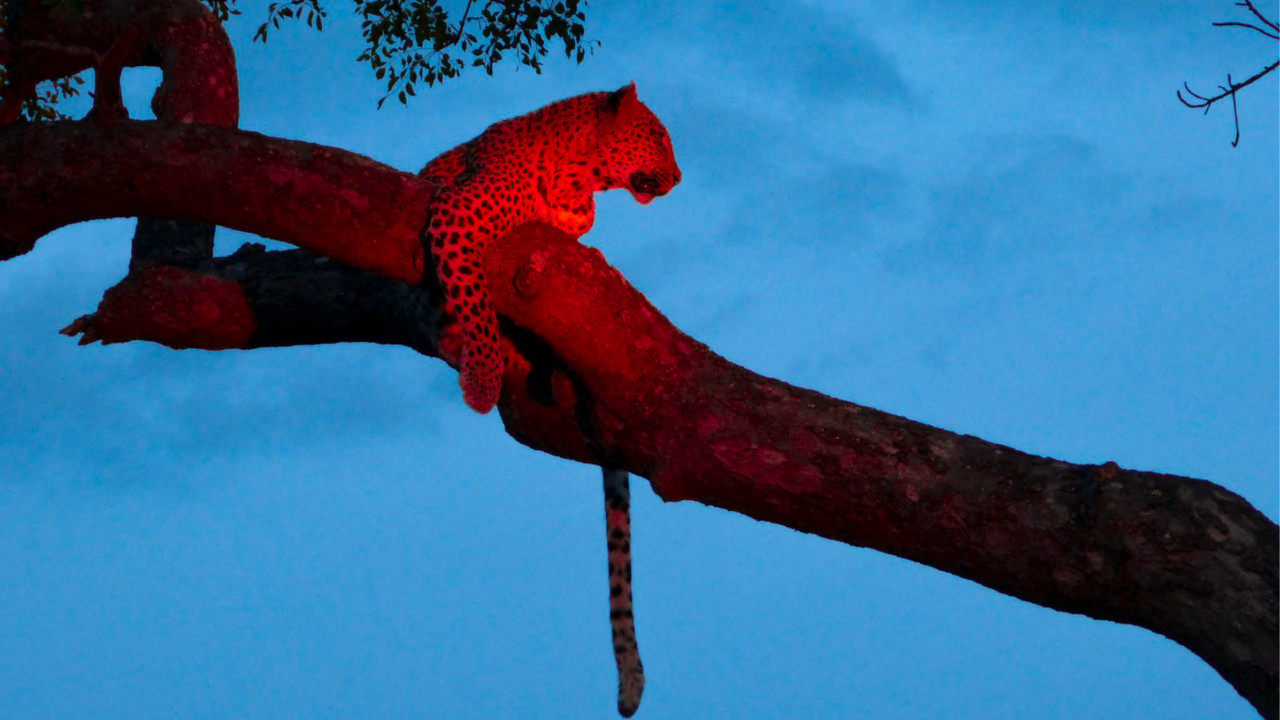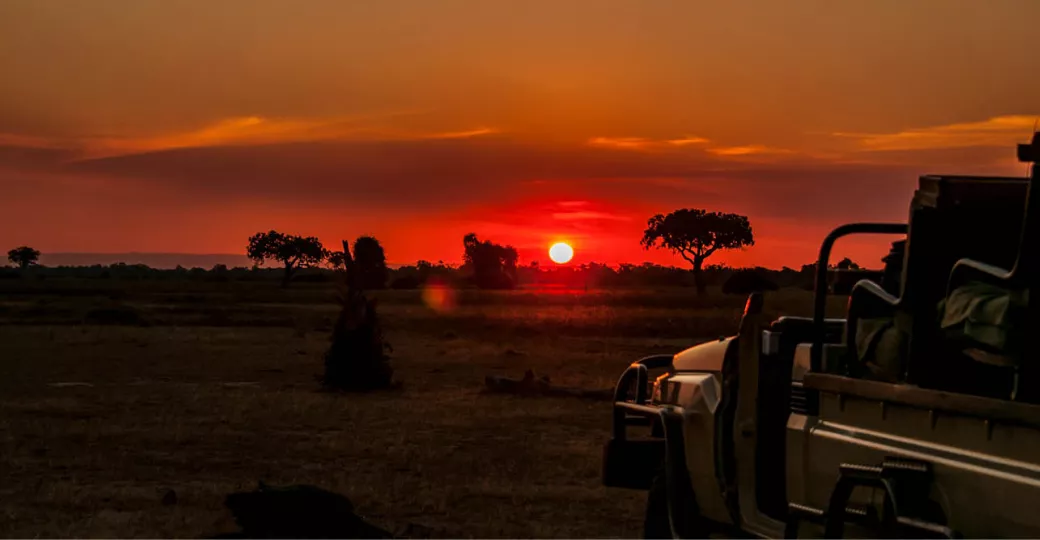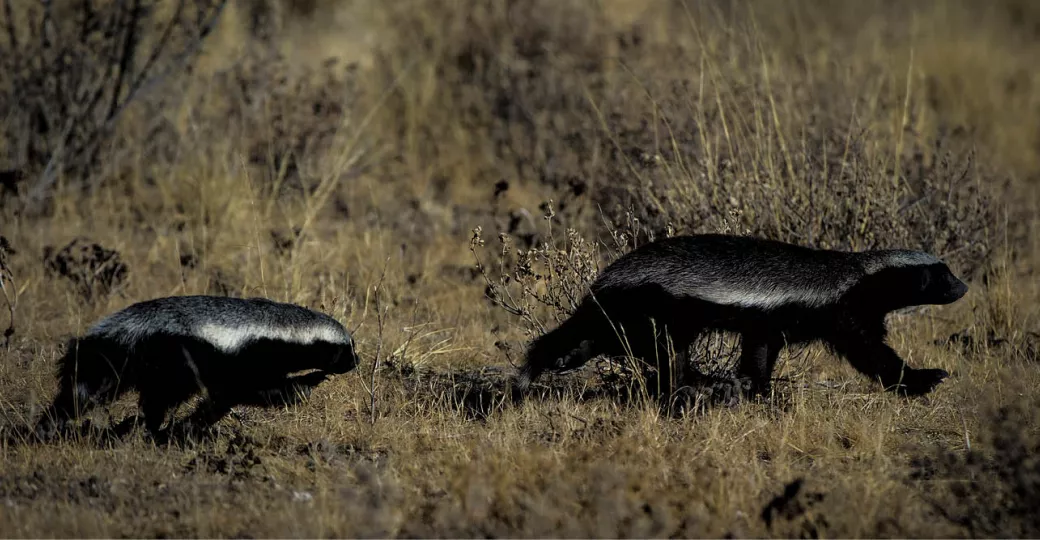
Going on safari is one of life’s biggest privileges.
Done well it allows you the chance to completely disconnect from the busy lives we all lead, and connect with nature and wildlife. There’s nothing quite like it!
By properly connecting with nature we are able to form a deep respect for it. It’s with this respect we must make it our responsibility to preserve the incredible habitats and wildlife by having as little impact as possible.
Excitingly, there is currently so much being done to ensure our impact is minimal. In this notebook we share with you the importance of using red filters on night drives.

© Toby Pheasant, Time + Tide Nsolo
To kick things off, what is a ‘night drive’?
Night drives are when you explore the bush after dark, either on your way back from an afternoon game drive or a special excursion into the night after dinner.
A night drive gives you the opportunity to see many of the nocturnal and crepuscular animals that are inactive during the heat of the day. With aardvark, bushbabies, genet, civet, honeybadger, porcupine all doing their daily business during this time, you’ll be amazed how much wildlife comes out after the sun goes down! Given their fantastic low-light vision and the much cooler conditions, this is also when many predators such as lion, leopard, serval and hyena are most active and do the majority of their hunting.

© Dana Allen, Kalahari Plains Camp
So, what’s the problem with the spotlights?
The way that we have traditionally found these animals at night is by using a bright white spotlight, scanning quickly from left to right and up and down hoping to spot the reflection from the animals’ eyes.
Once spotted and identified as a nocturnal animal, you would then stop and view the animal with that same white spotlight. The problem with this is it’s hugely insensitive and disruptive to the animal.
If you have ever been walking around at night with your eyes ‘adjusted’ to the dark and then had a spotlight shone on you, you will know the feeling of being temporarily blinded for a few moments. If not, try it! It’s actually takes a surprisingly long time for your eyes to re-adjust to seeing in the dark again.
Now imagine being a zebra at night in the African bush, not knowing if there’s a pride of lions waiting to ambush you, and then being blinded by a spotlight. You would immediately become distressed and disorientated, and the ultimate outcome may be different to how nature had intended. On the other hand, if it’s a predator that has been spotted, it could potentially expose it to potential prey, thus spoiling a hunt.
To overcome this issue whilst on a night drive, respectful lodges will use red light filters on their spotlights.

© Steve Felton, Etosha National Park
Why is red light less disruptive?
As most mammals (other than primates) are at least partially colour blind, red light is drastically less impactful to their night-vision than white light. There is ongoing research into whether they can see the red light at all!
It all comes down to the number of rods and cones in the eye. Rods are light-sensitive while cones are colour-sensitive. The majority of African mammals’ eyes consist of many more rods than cones and are therefore more sensitive to light. It’s this sensitivity that gives them their superior night-vision.
It’s the job of the pupil to control the amount of light that enters the eye. Over the course of a day, the shift in brightness occurs very slowly and the pupil is capable of adjust naturally. When a man-made spotlight catches an animals eye however, the eye is instantly exposed to far too much light and the animal is effectively blinded. With a higher percentage of the light-sensitive rods than colour-sensitive cones, the animals are much more susceptible to changes in brightness.
If you have seen videos of predators at night being spotted with a white light directly into their eyes, you may notice that they tend to sit or lie down. This isn’t for the guests to take a nice photo, it’s solely because they are blinded and the safest thing for them to do is stop and wait for their eyes to readjust - something that can take 30 minutes to an hour!

© Toby Pheasant, Time + Tide Nsolo
What about my photos?
Thanks to the wonders of modern technology, a combination of playing around on your camera settings and using photo editing software can make your photos look fantastic. Combine these tools with the added benefit of a lack of intrusion the red light filter gives, and you’ll be able to get some incredible shots!
Most well trained guides at good lodges will be able to assist you with you settings before your night drive and will be able to advise on how to edit them when you get back to a computer.

© Toby Pheasant, Duma Tau Camp
Sadly, not all camps and lodges in Africa use red light filters on night drives. If you are interested in finding out more about this topic and finding a lodge that uses red light filters, we will be happy to help.

Toby Pheasant
Toby first visited Africa at the tender age of four when he accompanied his family on their first of several safari holidays. From that moment on Toby’s love affair with Africa’s nature and wildlif...
View profileNever miss a notebook entry with our newsletter


